J&DHS Inc. 2000
- JAMIESON
& DISTRICT HISTORICAL SOCIETY Inc.
- COURTHOUSE
-
MUSEUM
-
UPPER GOULBURN TOURIST REGION
- JAMIESON
You are here
- JAMIESON
PRIMARY SCHOOL 814
-
WOODS POINT
-
Other towns
of the
UPPER GOULBURN
- RESEARCH
FACILITIES
- BOOKS
FOR SALE
- OTHER LINKS

Mansfield Online
Locate local businesses
Emporium of the Ranges
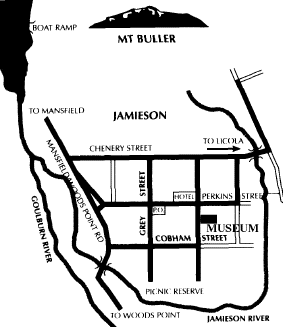
Following the discovery of gold
at Cashens Point in 1854, the first signs of a settlement
began appearing on what was then known as Jamieson Flat. Said
to be named for George Jamieson, who lived on the flat around
1850.
It was not really a gold mining town, rather a supply town.
From Jamieson supplies would be packed by horse and mule along
the narrow tracks to the diggers on the goldfields of the
Upper Goulburn.
At its peak Jamieson had a population of 3000 to 4000, today
the permanent population averages around 100.
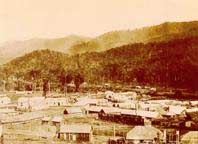
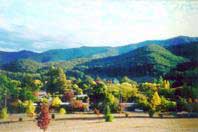
Many of the old buildings have
been preserved, they include:
The Jamieson Courthouse (1864) home of the
Jamieson &
District Historical Society Inc.where
a display of the areas past can be viewed in the Museum
between 11am and 3pm on Weekends and Public Holidays from
November to Easter, and
Jamieson Primary School 814 as well as the old
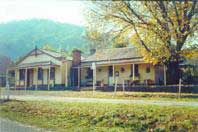
Built in 1867 as the Colonial Bank and managers
residence for Edwin Fitzroy Lusignan the first Bank
Manager, a position he held for 18 years.
A much respected man, when he moved to Benalla in 1885 a
dinner was held in his honour at the Junction Hotel and a
presentation of 50 guineas ($105) was made.
The National Bank merged with the Colonial Bank in 1918
then in 1925 the Jamieson Branch closed and business was
transferred to Mansfield.
The building then became a storeroom and extra
accommodation for the Junction Hotel which was located
next door.
Between 1948-52 the building was used as a residence for
the publicans family and when the hotel was burnt down in
January 1961, the building was utilised as a temporary
bar.
The last Licensee, Mrs. Dorothy Denholme, surrendered the
104 year old licence in 1965. The licence was transferred
to the Kooroora Motel which then became the Lakeside
Hotel.
JAMIESON CHURCHES
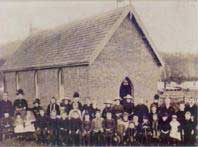

ST. PETERS CHURCH OF ENGLAND above left
Surrounded by 100 year old oaks, sycamores and pines this
beautiful old church was inaugurated on September 28th
1865 with full Masonic honours.
The first Rector was Rev. Frederick Smith who came to the
Parish in April 1865.
The main structure is built of local handmade bricks with
a shingle roof (now covered by galvanised iron for
protection), the porch and wooden vestry were added at a
later date. The interior roof beams are extremely solid
and the pulpit is hand carved Lebanon Cedar.
Below left is St Peters as it was in 1865
ST. JOHNS ROMAN CATHOLIC CHURCH above right
Father Patrick Kavanagh was the first Priest for the
Parish, which covered the district from Mansfield to
Jericho. It was he who selected the land for the church to
be built on. The site was gazetted in 1863 and the first
building a small timber chapel(below right) was erected to
the left of the current church in 1865.
Father Patrick Courtney became St. Johns first Priest and
Michael Ridge was the first Trustee. The present building,
was built in 1899.
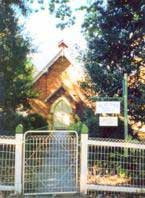

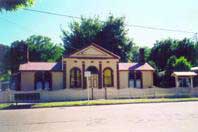
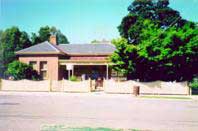
JAMIESON MEMORIAL HALL above left
Following a Grand Opening Ball in 1883 the building was
used as the Town Hall and Howqua Shire Offices until
amalgamation with Mansfield in 1919.
This building was then turned over to the people of
Jamieson as a memorial to those who fought in WWI.
After the Anzac Day Parade each year a Memorial Service is
held here by the Upper Goulburn Branch of the RSL.
Fully restored in 1991, this community meeting place can
be hired from the Hall Committee for functions.
JAMIESON POST OFFICE above right
The original Post and Telegraph Office was on the lower
side of Bank Street. When the Oriental Bank closed in
1865, Robert Kennedy, the Postmaster at the time, moved
the Post Office to the old bank building, across the
street.
The Jamieson Chronicle of June 1868 tells us the Post
Office and Telegraph Station by this time was adjacent to
the Courthouse Hotel.
The present Post Office building was built in 1872 and
opened for business soon after. It has operated as the
Jamieson Post Office ever since.
The telephone was connected to the district in the late
1890s making the Telegraph obsolete. The single wire party
line from Mansfield to Woods Point remained in service
until after WWll
June Mason was the telephonist until the 1970s, when the
exchange was automated. June was Jamiesons best known
Postmistress, she succeeded her Aunt Glady Wray in 1954,
and held the position for 30 years until her retirement in
1984.